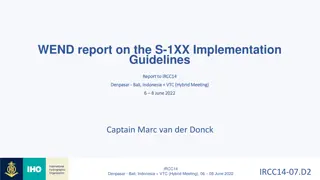
Signed Binary Numbers and Binary Codes in Digital Electronics
Learn how signed binary numbers are represented in digital electronics using sign-magnitude form, understand the concept of sign-1's complement, and explore examples to grasp the fundamentals of binary representations for both positive and negative numbers.
Download Presentation

Please find below an Image/Link to download the presentation.
The content on the website is provided AS IS for your information and personal use only. It may not be sold, licensed, or shared on other websites without obtaining consent from the author. If you encounter any issues during the download, it is possible that the publisher has removed the file from their server.
You are allowed to download the files provided on this website for personal or commercial use, subject to the condition that they are used lawfully. All files are the property of their respective owners.
The content on the website is provided AS IS for your information and personal use only. It may not be sold, licensed, or shared on other websites without obtaining consent from the author.
E N D
Presentation Transcript
DIGITAL ELECTRONICS UNIT-1 SIGNED BINARY NUMBERS & BINARY CODES
So far we have used only positive numbers in our discussion. But in everyday practice, we need a method to represent positive numbers as well as negative numbers. In the decimal number system, we use a plus (+) sign to denote positive numbers and a minus (-) sign to denote negative numbers.
The digital circuits understand only the two binary symbols 0 and 1. Therefore, we have to employ only these two symbols to represent the sign of the number. The usual method is to allot a separate bit to indicate the sign of the number.
The bit 0 is used to represent (+) or positive numbers and the bit 1 is used to represent (-) or negative numbers. The bit that is used to represent the sign of the number is called the sign bit. The sign bit is the most significant bit (MSB) of a binary number.
For a positive number, the MSB is equal to 0 and the remaining bits represent the magnitude. This type of representation is called sign-magnitude form. Let us take a few examples with one sign bit and seven bits to represent magnitude.
DECIMAL SIGN-MAGNITUDE +14 0 000 1110 -14 1 000 1110 +95 0 101 1111 -95 1 101 1111 +127 0 111 1111 -127 1 111 1111
In the sign-magnitude form, another point to note is that 0 is represented as +0 -0 0 1 000 1 0000 and 0000 The negative numbers are represented with a 1 as sign bit in the MSB position and the magnitude part can be represented in any one of three different ways 1. Sign-magnitude 2. Sign-1 s complement 3. Sign-2 s complement
Sign-1 complement To represent a negative number in 1 s complement form, the following two steps are used. 1. Write the positive binary form of the number, including the sign bit. 2. Invert each bit, including the sign bit, ie.,take 1 s complement For example, the sign-1 s complement representation for -12 is obtained as follows +12 = 0 000 1100 -12 = 1 111 0011
Similarly the sign -1s complement representation for -93 is obtained as +93 = 0 101 1101 -93 = 1 010 1110 Similarly the range -127 to + 127 is represented as +127 = 0 111 1111 -127 = 1 000 0000
Sign 2s complement The sign-2 s complement for -12 is obtained as follows + 12 = 0 000 1100 1 s complement of +12 = 1 111 0011 Add 1 1 ------------------------- -12 = 1 1 1 1 0 1 0 0 -------------------------
Add +95 and + 27 + 95 + 27 ------ + 122 ------- = 0 = 0 ------------------------- 0 111 1010 -------------------------- 101 001 1111 + 1011
+95 and - 27 + 95 - 27 ------ + 68 ------- The carry produced is ignored. The MSB is 0 indicating the result is positive and in true binary form = 0 = 1 ------------------------- 1 0 100 0100 -------------------------- 101 110 1111 + 0101










